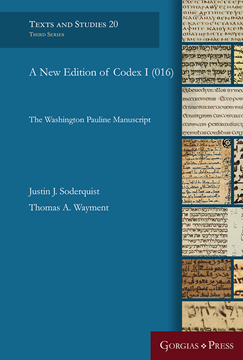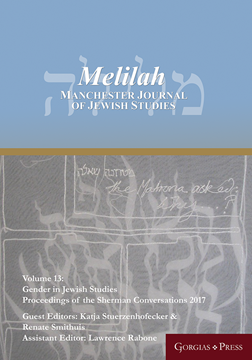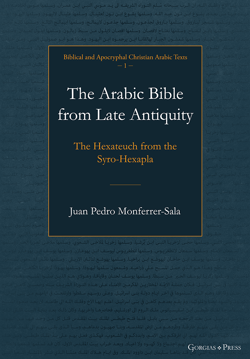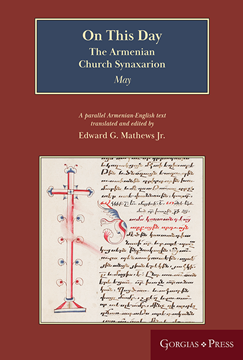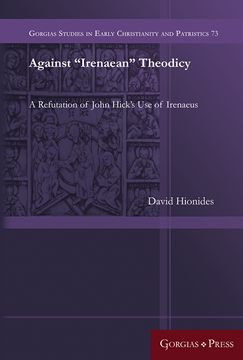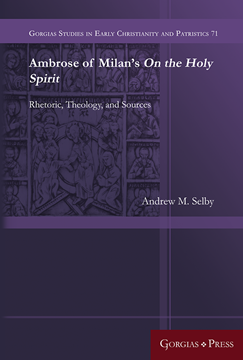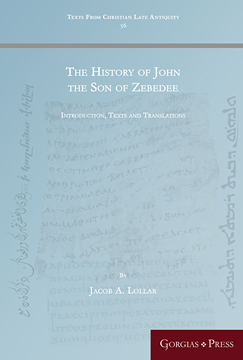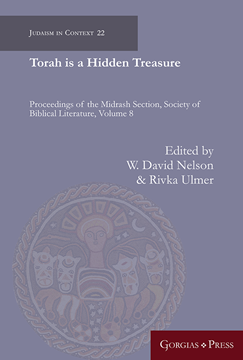A New Edition of Codex I (016)
The Washington Pauline Manuscript
Series: Texts and Studies (Third Series) 20
ISBN: 978-1-4632-4054-7
Nearly a century has passed since Henry A. Sanders first published his editio princeps of the Washington Manuscript of the Epistles of Paul (Codex I or GA 016). Within that time, it has received very little scholarly attention. This new edition provides a fresh, conservative transcription based on two new image sets.
$149.50 (USD) $89.70 (USD)
Gender in Jewish Studies
Proceedings of the Sherman Conversations 2017
Edited by Katja Stuerzenhofecker & Renate Smithuis
ISBN: 978-1-4632-4056-1
Volume 13 of Melilah, an interdisciplinary electronic journal concerned with Jewish law, history, literature, religion, culture and thought in the ancient, medieval and modern eras.
$69.00 (USD) $41.40 (USD)
The Arabic Bible from Late Antiquity
The Hexateuch from the Syro-Hexapla
Edited by Juan Pedro Monferrer-Sala
ISBN: 978-1-4632-4058-5
The biblical material translated into Arabic during the Middle Ages included texts from the Hexateuch contained in Codex Sinai Arabic 3, the first in the Christian Arabic Texts series now being published. This set of six texts (Pentateuch + Joshua) is of enormous interest, for what it tells us not only about translating into Arabic, and about the techniques and strategies adopted by the translators, but also about the revisions and reworkings to which the original translations were subjected, and in general about the transmission process undergone by biblical texts in the hands of successive copyists.
$149.50 (USD) $89.70 (USD)
The Mystical Tradition of the Eastern Church
Studies in Patristics, Liturgy, and Practice
Edited by Sergey Trostyanskiy & Jess Gilbert
Series: Gorgias Eastern Christian Studies 56
ISBN: 978-1-4632-4060-8
This volume presents the work of contemporary Orthodox thinkers who attempt to integrate the theological and the mystical. Exciting and provocative chapters treat a wide variety of mysticism, including early Church accounts, patristics (including the seemingly ever-popular subject of deification), liturgy, iconography, spiritual practice, and contemporary efforts to find mystical sense in cyber-technologies and post-humanism.
$114.95 (USD) $68.97 (USD)
On This Day (May)
The Armenian Church Synaxarion (Yaysmawurkʿ)
Edited and Translated by Edward G Mathews Jr
ISBN: 978-1-4632-4064-6
The Armenian Church Synaxarion is a collection of saints’ lives according to the day of the year on which each saint is celebrated. Part of the great and varied Armenian liturgical tradition from the turn of the first millennium, the first Armenian Church Synaxarion represented the logical culmination of a long and steady development of what is today called the cult of the saints. This volume, the first Armenian-English edition, is the fifth of a twelve-volume series—one for each month of the year—and is ideal for personal devotional use or as a valuable resource for anyone interested in saints.
$98.00 (USD) $58.80 (USD)
Against “Irenaean” Theodicy
A Refutation of John Hick's Use of Irenaeus
ISBN: 978-1-4632-4071-4
This book serves to correct the now accepted understanding of Irenaeus’s theodicy. This assumption of Hick’s theodicy as legitimately “Irenaean” remains due the gulf between Irenaean scholarship and discussion of the problem of evil. The present work offers a bridge between the two to allow for the continued discussion of both theologian’s distinct views.
$146.00 (USD) $87.60 (USD)
Ambrose of Milan's On the Holy Spirit
Rhetoric, Theology, and Sources
By Andrew Selby
ISBN: 978-1-4632-4074-5
Despite being the first extended defense of the divinity of the Holy Spirit written in Latin and influencing the Trinitarian theology of Augustine of Hippo, Ambrose of Milan’s On the Holy Spirit (De Spiritu Sancto) has received little scholarly attention. This book seeks to change this perspective by claiming that Ambrose defines the Holy Spirit in a way consistent with pro-Nicene theology using classical Ciceronian rhetoric to interpret Scripture in a quasi-judicial situation.
$158.00 (USD) $94.80 (USD)
The History of John the Son of Zebedee
Introduction, Texts and Translations
Series: Texts from Christian Late Antiquity 56
ISBN: 978-1-4632-4075-2
Many stories and legends about John the son of Zebedee have survived from antiquity. He was known as one of the twelve disciples of Jesus Christ, as the “Beloved Disciple” and author of the Gospel of John, and even as the recipient of the divine revelation in the Apocalypse. Later traditions, such as the Greek Acts of John, told of how John traveled to Ephesus and converted people to Christianity. John was an important figure to Catholic Christians, to Gnostic Christians, and to Manichaeans. He also found a distinct place among Syriac Christians who preserved their own story about John’s acts in Ephesus. William Wright first introduced the History of John in 1871 using two manuscript witnesses. Since then, more witnesses have been discovered, but little work has been done on this native Syriac apocryphon. The present volume brings together all of the known Syriac witnesses to the History of John with a new translation and includes, for the first time, a critical discussion of the history, provenance, and importance of this text for the study of Syriac Christianity and Christian Apocrypha more generally.
$114.95 (USD) $68.97 (USD)
A Critical Edition of Kitāb al-Sawād al-aʿẓam by al-Ḥakīm al-Samarqandī
By Maher Jarrar
Series: Islamic History and Thought 27
ISBN: 978-1-4632-4077-6
The book comprises an annotated critical edition and a detailed study of Kitāb al-Sawād al-a‘ẓam by al-Ḥakīm al-Samarqandī (d. 342/953).
$138.00 (USD) $82.80 (USD)
Torah is a Hidden Treasure
Proceedings of the Midrash Section, Society of Biblical Literature
Edited by W. David Nelson & Rivka Ulmer
Series: Judaism in Context 22
ISBN: 978-1-4632-4078-3
The chapters in Torah is a Hidden Treasure pertain to authorship in Seder Eliyahu Rabba and Pirqe deRabi Eliezer, natural law and Israel’s statutes, Masorah and midrash, as well as a definition of midrash. The Hebrew Bible and midrash is researched in the interpretation of Israelite tribes, the Ten Commandments and the Covenant Code, and in Rashbam’s Bible commentary and its exegetical devices.
$128.00 (USD) $76.80 (USD)
